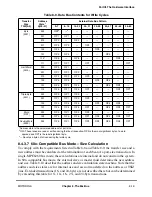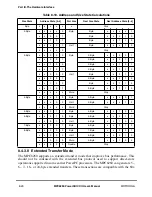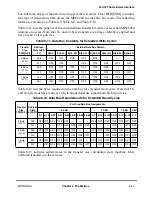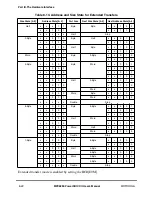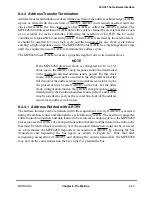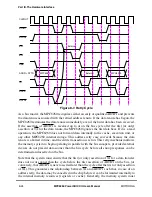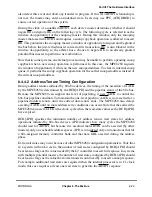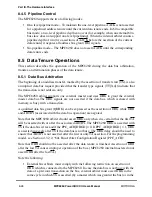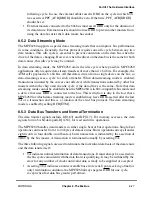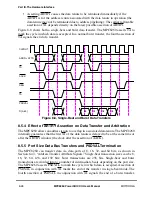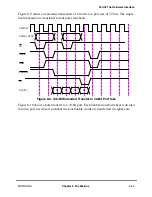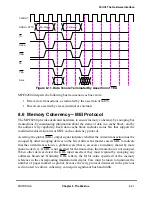
MOTOROLA
Chapter 8. The 60x Bus
8-33
Part III. The Hardware Interface
8.7.1 Support for the lwarx/stwcx. Instruction Pair
The load word and reserve indexed (
lwarx
) and the store word conditional indexed (
stwcx.
)
instructions provide a way to update memory atomically by setting a reservation on the load
and checking that the reservation is still valid before the store is performed. In the
MPC8260, reservations are made on behalf of aligned, 32-byte sections of the memory
address space.
The reservation (RSRV) output signal is driven synchronously with the bus clock and
reßects the status of the reservation coherency bit in the reservation address register.
Note that each external master must do its own snooping; the MPC8260 does not provide
external reservation snooping.
8.7.2 TLBISYNC Input
The TLBISYNC input permits hardware synchronization of changes to MMU tables when
the MPC8260 and another DMA master share the MMU translation tables in system
memory. A DMA master asserts TLBISYNC when it uses shared addresses that the
MPC8260 could change in the MMU tables during the DMA masterÕs tenure.
When the TLBISYNC input is asserted, the MPC8260 cannot complete any instructions
past a
tlbsync
instruction. Generally, during the execution of an
eciwx
or
ecowx
instruction, the selected DMA device should assert the MPC8260Õs TLBISYNC signal and
hold it asserted during its DMA tenure if it is using a shared translation address. Subsequent
instructions by the MPC8260 processor should include a
sync
and
tlbsync
instruction
before any MMU table changes are performed. This prevents the MPC8260 from making
disruptive table changes during the DMA tenure.
8.8 Little-Endian Mode
The MPC8260 supports a little-endian mode in which low-order address bits are operated
on (munged) based on the size of the requested data transfer. This mode allows a little-
endian program running on the processor with a big-endian memory system to offset into
a data structure and receive the same results as it would if it were operating on a true little-
endian processor and memory system. For example, writing a word to memory as a word
operation on the bus and then reading in the second byte of that word as a byte operation
on the bus.
Note that when the processor is selected for little-endian operation, the bus interface is still
operating in big-endian mode. That is, byte address 0 of a double word (as selected by
A[29Ð31] on the busÑafter the internal address munge) still selects the most signiÞcant
(left most) byte of the double word on D[0Ð7]. If the processor interfaces with a true little-
endian environment, the system may need to perform byte-lane swapping or other
operations external to the processor.
Summary of Contents for MPC8260 PowerQUICC II
Page 1: ...MPC8260UM D 4 1999 Rev 0 MPC8260 PowerQUICC II UserÕs Manual ª ª ...
Page 66: ...lxvi MPC8260 PowerQUICC II UserÕs Manual MOTOROLA ...
Page 88: ...1 18 MPC8260 PowerQUICC II UserÕs Manual MOTOROLA Part I Overview ...
Page 120: ...2 32 MPC8260 PowerQUICC II UserÕs Manual MOTOROLA Part I Overview ...
Page 138: ...Part II iv MPC8260 PowerQUICC II UserÕs Manual MOTOROLA Part II Configuration and Reset ...
Page 184: ...4 46 MPC8260 PowerQUICC II UserÕs Manual MOTOROLA Part II ConÞguration and Reset ...
Page 202: ...Part III vi MPC8260 PowerQUICC II UserÕs Manual MOTOROLA Part III The Hardware Interface ...
Page 266: ...8 34 MPC8260 PowerQUICC II UserÕs Manual MOTOROLA Part III The Hardware Interface ...
Page 382: ...10 106 MPC8260 PowerQUICC II UserÕs Manual MOTOROLA Part III The Hardware Interface ...
Page 392: ...11 10 MPC8260 PowerQUICC II UserÕs Manual MOTOROLA Part III The Hardware Interface ...
Page 430: ...Part IV viii MOTOROLA Part IV Communications Processor Module ...
Page 490: ...14 36 MPC8260 PowerQUICC II UserÕs Manual MOTOROLA Part IV Communications Processor Module ...
Page 524: ...17 10 MPC8260 PowerQUICC II UserÕs Manual MOTOROLA Part IV Communications Processor Module ...
Page 556: ...18 32 MPC8260 PowerQUICC II UserÕs Manual MOTOROLA Part IV Communications Processor Module ...
Page 584: ...19 28 MPC8260 PowerQUICC II UserÕs Manual MOTOROLA Part IV Communications Processor Module ...
Page 632: ...21 24 MPC8260 PowerQUICC II UserÕs Manual MOTOROLA Part IV Communications Processor Module ...
Page 652: ...22 20 MPC8260 PowerQUICC II UserÕs Manual MOTOROLA Part IV Communications Processor Module ...
Page 668: ...23 16 MPC8260 PowerQUICC II UserÕs Manual MOTOROLA Part IV Communications Processor Module ...
Page 758: ...27 28 MPC8260 PowerQUICC II UserÕs Manual MOTOROLA Part IV Communications Processor Module ...
Page 780: ...28 22 MPC8260 PowerQUICC II UserÕs Manual MOTOROLA Part IV Communications Processor Module ...
Page 874: ...29 94 MPC8260 PowerQUICC II UserÕs Manual MOTOROLA Part IV Communications Processor Module ...
Page 920: ...31 18 MPC8260 PowerQUICC II UserÕs Manual MOTOROLA Part IV Communications Processor Module ...
Page 980: ...A 4 MPC8260 PowerQUICC II UserÕs Manual MOTOROLA Appendixes ...
Page 1002: ...Index 22 MPC8260 PowerQUICC II UserÕs Manual MOTOROLA INDEX ...
Page 1006: ......

